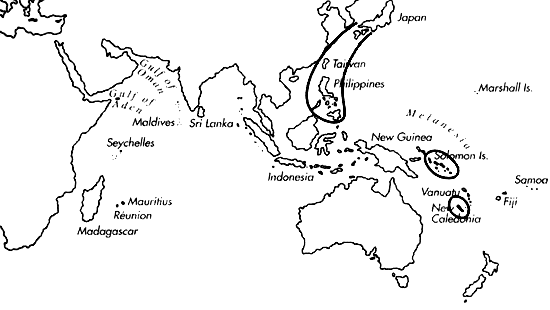
Skip Navigation Links
View access keys for this site.

Range: Japan to Taiwan and Philippines, Solomon Is., and Loyalty Is.
Description: Moderately large to large, solid. Last whorl ventricosely conical, broadly and ventricosely conical or pyriform; outline convex at adapical two-thirds, straight to concave below; left side consistently sigmoid. Shoulder angulate to subangulate, approaching rounded in very large shells. Spire high, stepped, outline slightly concave. First 8-12 postnuclear whorls tuberculate. Early teleoconch sutural ramps flat to concave, with 2-3 spiral grooves; late ramps deeply concave with a weak spiral striation. Last whorl with weak spiral ribs at base.
| Shell Morphometry | ||
|---|---|---|
| L | 68-100 mm | |
| RW | 0.37-0.74 g/mm | |
| (L 68-88 mm) | ||
| RD | 0.63-0.73 | |
| PMD | 0.78-0.85 | |
| RSH | 0.26-0.30 | |
Groundcolour white. Last whorl with about 7-13 reddish brown dotted spiral lines. Irregular, reddish to dark brown flecks often form an interrupted spiral band above centre. Teleoconch sutural ramus with a variable number of brown radial streaks and blotches extending across outer margins onto steps. Aperture white.
Periostracum yellowish brown, thin, translucent, smooth.
Habitat and Habits: In 150-430 m.
Discussion: C. stupa is most similar to its simultaneously described close ally C. stupella, sympatric in Japanese andTaiwanese waters. For the distinctions, see the Discussion of the latter species.

C. stupa range map
This section contains verbatim reproductions of the accounts of 316 species of Conus from the Indo-Pacific region, from Manual of the Living Conidae, by Röckel, Korn and Kohn (1995). They are reproduced with the kind permission of the present publisher, Conchbooks.
All plates and figures referred to in the text are also in Röckel, Korn & Kohn, 1995. Manual of the Living Conidae Vol. 1: Indo-Pacific Region.
The range maps have been modified so that each species account has it own map, rather than one map that showed the ranges of several species in the original work. This was necessary because each species account is on a separate page on the website and not confined to the order of accounts in the book.
Return to framed version (returns to search page)